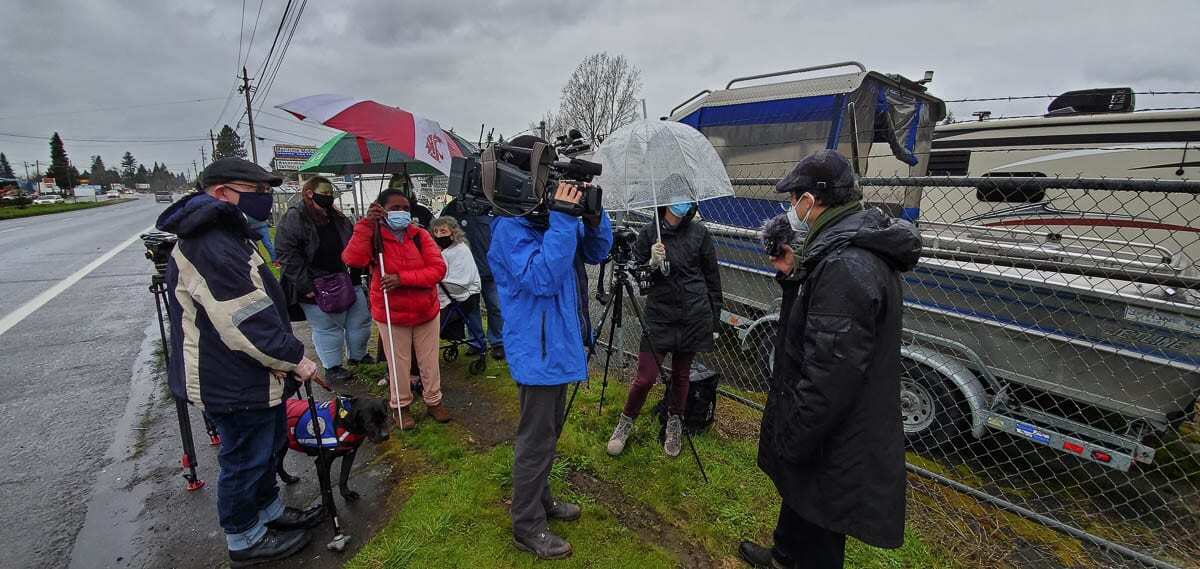Mobility initiative groups live streamed crossing St. James Rd. and St. Johns Blvd. in Vancouver
Picture yourself standing on the edge of a busy street waiting for the signal to walk across.
It’s windy, rainy and you’re on a muddy, uneven surface. There should be a sidewalk leading to the intersection, but for whatever reason, there isn’t. So you nervously wait your turn, and hope the drivers are double checking for pedestrians.

When the signal changes, do you feel safe to cross the road? Most able-bodied individuals can walk across the intersection quickly while keeping an eye on all the motorists. But, what do you do if you can’t see, can’t hear, or need a cane or wheelchair to move?
Betty Fitzpatrick and her three daughters live near the three-way intersection of Minnehaha, St. James and St. Johns streets in Vancouver. They have contacted city and county officials about installing pedestrian accessible signals at those intersections and having sidewalks constructed on both sides of the roads. On Thursday, Fitzpatrick and other disabled Clark County residents spoke during the Disability Rights Washington and Front and Centered mobility initiative group’s livestream conference on location.
“We’ve been told this is a city issue or the city says it’s a county issue,” Fitzpatrick said. “We don’t really want to fuss over who’s issue it is, we just would like to get sidewalks and pedestrian accessible lights here.”
Chris Higley, a Vancouver resident for 20 years, described how audio and visual cues could help pedestrians at those intersections.
“St. Johns and St. James are both one-direction roads, and that means vehicles are going at a high rate of speed,” Higley said. “I’m standing on grass, where a sidewalk is supposed to be. It’s very loud, and there is no audible or verbal crossing to help me understand when it’s safe to go. And because vehicles are coming at such a fast rate of speed, I worry about getting hit.”
Abby Griffith takes a 15-minute walk each day from where she lives in Vancouver to the closest bus stop. A 20-minute ride to her classes at Washington State University Vancouver takes more than two hours because she has to make two transfers each way.
“Walking from my house to the bus stop is a real struggle for me. It’s just so exhausting to leave my house because of that,” Griffith said. “What does it take to put bus stops closer to low income housing? People living with low income rely on public transportation.”
After the conference, Griffith, Higley and other speakers demonstrated how difficult it is to cross St. James and St. Johns roads on foot by taking the livestream audience with them across the intersections.
Front and Centered Transportation Lead Paulo Nunes-Ueno pointed to the side of St. James Road without a sidewalk and said, “What you see here, this is unfinished business. Washington state has a backlog of over $9 billion of sidewalk and active transportation facilities that are not done. This is unfinished business and we have to get to it.”
According to Disability Rights Washington Program Director Anna Zivarts, cities and counties can apply for grants from the Washington State Department of Transportation to build new sidewalks, but the pool is so large and the chance of getting the funding is so low.
“Compared to what we are spending on highway projects, it’s not very much money that people are asking for but it’s not getting allocated,” Zivatis said.
Clark County Today sent questions to members from Clark County Public Works and has yet to receive a response. Zivatis hopes they can arrange a meeting with these officials and county residents, and together they can create a safer and affordable resolution for everybody.
“It’s not that cities and counties don’t want sidewalk and public transportation infrastructures to exist,” Zivatis said. “It’s just how can we get the funding to make it happen and where is it going to come from.”
Front and Centered and Disability Rights Washington spent the past six months interviewing community members in each Washington city, including Vancouver. Together, they are building a transportation roadmap to show where sidewalks and bus stops are needed. To participate, visit www.disabilityrightswa.org/storymap.




